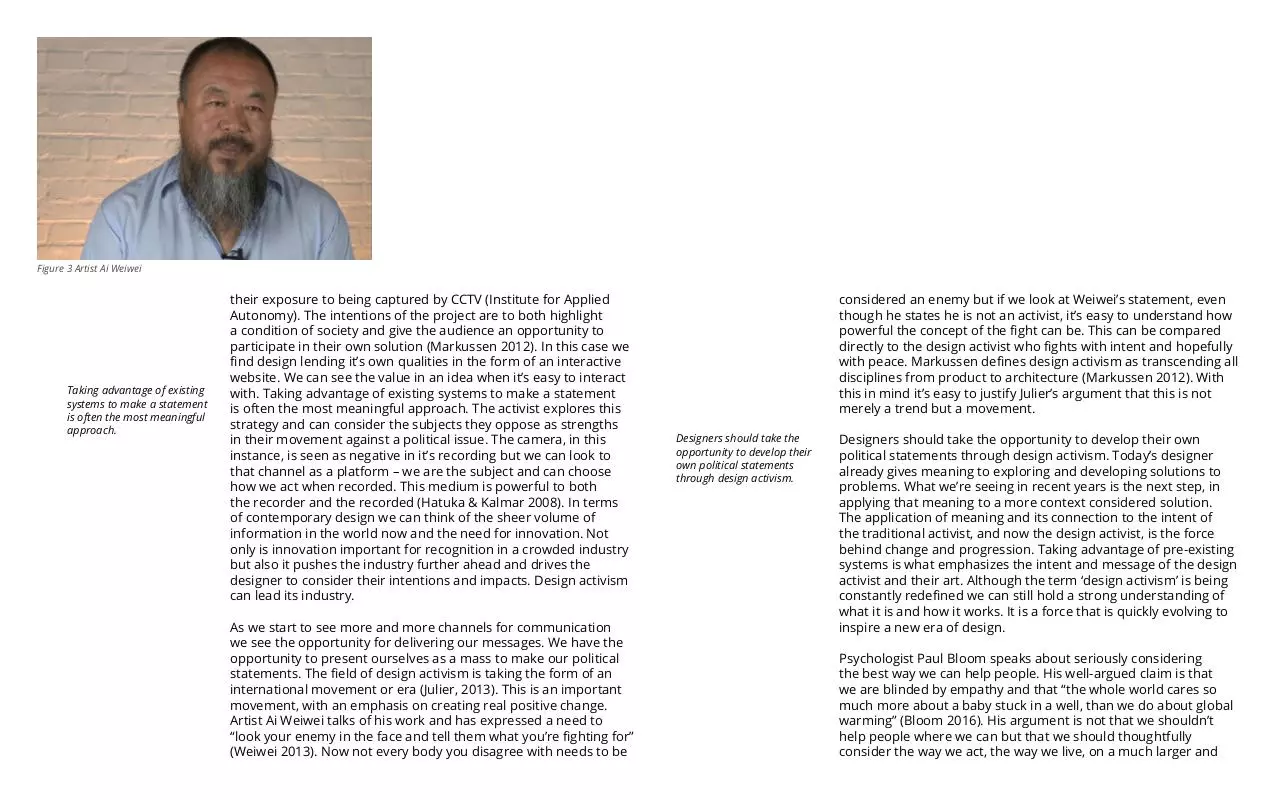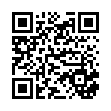CCDN331 P3 Warner Joshua (PDF)
File information
This PDF 1.7 document has been generated by Adobe InDesign CC 2014 (Macintosh) / Adobe PDF Library 11.0, and has been sent on pdf-archive.com on 03/05/2016 at 12:03, from IP address 222.153.x.x.
The current document download page has been viewed 334 times.
File size: 630.38 KB (4 pages).
Privacy: public file




File preview
The Role of Design Activism
Author: Joshua Warner
Course: CCDN331
Tutor: Tonya Sweet
Year: 2016
To understand design activism we must examine both the
designer and the activist. The extensive work of Faud-Luke
introduces the idea of a “delicious tension” between the two
words and acknowledges our inability to confidently define the
term (Fuad-Luke 2009). The activist is a well-known character
advocating a political cause, intent on creating change in a system
but obviously the design-activist is more complex than a designer
simply being an activist, or employing activist techniques.
We live in an age filled with growing concerns for the future of
the planet and the survival of humankind. This essay aims to
communicate an understanding of the design activist and explain
how the designer has an opportunity to make a political statement
through design activism, and why they should
“Design converts nature’s capital and man’s (human and financial)
capital into ‘man-made’ capital by giving it form, by embedding
meaning (by vesting the form with symbolic capital), by defining
societal values and, ultimately, by designing our perception of reality.”
Design Activism: Beautiful Strangeness for a Sustainable World - Alastair Fuad-Luke
Going forward this essay will explore the way meaning in design
ties itself to intent in activism.
Ideas need to be formed by
many and any solution will
come of collective opinion not
the opinion of a small governing body.
The interpretation of the ‘political’ is important to this argument.
In political science there is a strong distinction between the
conventional practice of politics and the political that “concerns
the very way in which society is instituted” (Mouffe 2000). It can
be understood that politics are the decisions and the structures
of governance whereas the political is the response and the
Figure 1 Taking the Street by Santiago Cirugeda
Figure 2 iSee by The Institute for Applied Autonomy
interaction resulting from that governance. Here we assess the
design activist’s relationship to political issues and their concern
for systems within set structures.
We can’t bind designs
presence in activism to its
pre-existing conventions.
The designer, driven by their intention, has an aim or a response
to a cause and, like the activist, seeks change in a system. But
the argument here is that the practice of design activism is not
a simple appearance of design in activism, like that observed by
Jody Boehnert in the Climate Camp 2007 march (Sinclair 2008). In
this case graphic design presents a strong visual representation
of the ideals held by the many activists, displaying the faces of
our diverse world printed on shields. The role design plays here is
outstanding but we can’t bind designs presence in activism to its
pre-existing conventions (Thorpe). In doing so true design activism
wouldn’t be achieved and by limiting the potential of design we
make a loss where more might be achieved. Design activism
should borrow from design and from activism but be free to
create its own conventions.
Projects of design activism that resist the status quo or the
existing structure they inhabit make strong political statements
and ask questions of their audience. This idea of questioning
through resistance can be seen in projects like ‘Taking the Street’
(Cirugeda). ‘Taking the Street’ (Fig. 1) takes advantage of local
legislation to provide a moment of play in the streets of Seville
in the form of a seesaw built into dumpsters. This installation
asks why an items presence in the city needs so much consent
and challenges the civic system in general. It repurposes the
public space. In this context design activism plays an important
role in identifying an issue. Participatory design like this makes
Simply informing the
inhabitants of a city what
the correct solution is would
be counter productive and
hypocritical.
Asking questions is a first
step, an important step, in
getting to the root of larger
political problems.
productive use of participants to involve them in the experiment
and in turn form their own opinions based on their experience.
There is importance in bringing these issues to the community
rather than simply bringing a solution. This installation, like
many others, is making a statement about a civic issue, simply
informing the inhabitants of a city what the correct solution is
would be counter productive and hypocritical. Ideas need to
be formed by many and any solutions will come of collective
opinion not the opinion of a small governing body. This project
has been described as applying “resistance that can be used to
suspend existing structures of power” (Markussen, 2012). In this
case the governing body has no power over deciding whether
or not the piece should be on the street, Cirugeda followed all
procedures to gain permission to occupy the space. The value of
design activists making statements and asking questions is a first
step, an important step, in getting to the root of larger political
problems. The solutions to problems that are discovered through
these means are often more successful. Design practices enforce
their traditional approaches and conventions to problems and as
a result of this the force that design as activism applies has the
opportunity to redefine the purpose design has in society.
Surveillance is a tool of the government, the industry and of the
individual. Its presence can put people at ease, provide a sense
of security and protection but more often we are presented
with the issue that too much surveillance poses a loss of privacy.
Design activism can play a strong role in the communication of
how important ones privacy is. In the case of the iSee (Fig. 2)
project the issue of surveillance is contested, where the citizen is
given the ability to find a way to navigate that city while limiting
Figure 3 Artist Ai Weiwei
Taking advantage of existing
systems to make a statement
is often the most meaningful
approach.
their exposure to being captured by CCTV (Institute for Applied
Autonomy). The intentions of the project are to both highlight
a condition of society and give the audience an opportunity to
participate in their own solution (Markussen 2012). In this case we
find design lending it’s own qualities in the form of an interactive
website. We can see the value in an idea when it’s easy to interact
with. Taking advantage of existing systems to make a statement
is often the most meaningful approach. The activist explores this
strategy and can consider the subjects they oppose as strengths
in their movement against a political issue. The camera, in this
instance, is seen as negative in it’s recording but we can look to
that channel as a platform – we are the subject and can choose
how we act when recorded. This medium is powerful to both
the recorder and the recorded (Hatuka & Kalmar 2008). In terms
of contemporary design we can think of the sheer volume of
information in the world now and the need for innovation. Not
only is innovation important for recognition in a crowded industry
but also it pushes the industry further ahead and drives the
designer to consider their intentions and impacts. Design activism
can lead its industry.
As we start to see more and more channels for communication
we see the opportunity for delivering our messages. We have the
opportunity to present ourselves as a mass to make our political
statements. The field of design activism is taking the form of an
international movement or era (Julier, 2013). This is an important
movement, with an emphasis on creating real positive change.
Artist Ai Weiwei talks of his work and has expressed a need to
“look your enemy in the face and tell them what you’re fighting for”
(Weiwei 2013). Now not every body you disagree with needs to be
considered an enemy but if we look at Weiwei’s statement, even
though he states he is not an activist, it’s easy to understand how
powerful the concept of the fight can be. This can be compared
directly to the design activist who fights with intent and hopefully
with peace. Markussen defines design activism as transcending all
disciplines from product to architecture (Markussen 2012). With
this in mind it’s easy to justify Julier’s argument that this is not
merely a trend but a movement.
Designers should take the
opportunity to develop their
own political statements
through design activism.
Designers should take the opportunity to develop their own
political statements through design activism. Today’s designer
already gives meaning to exploring and developing solutions to
problems. What we’re seeing in recent years is the next step, in
applying that meaning to a more context considered solution.
The application of meaning and its connection to the intent of
the traditional activist, and now the design activist, is the force
behind change and progression. Taking advantage of pre-existing
systems is what emphasizes the intent and message of the design
activist and their art. Although the term ‘design activism’ is being
constantly redefined we can still hold a strong understanding of
what it is and how it works. It is a force that is quickly evolving to
inspire a new era of design.
Psychologist Paul Bloom speaks about seriously considering
the best way we can help people. His well-argued claim is that
we are blinded by empathy and that “the whole world cares so
much more about a baby stuck in a well, than we do about global
warming” (Bloom 2016). His argument is not that we shouldn’t
help people where we can but that we should thoughtfully
consider the way we act, the way we live, on a much larger and
Reference
longer-term scale. The way this concept connects to design
activism can be seen by looking at the way we question and aim to
solve problems. There’s always a need to find solutions to issues
around us but design activism is about shaping a better world and
tackling larger issues, issues that might need to break the systems
we live by now.
Bloom, P. (2016, April 29). Against Empathy [Video file]. Retrieved
May 2, 2016, from https://vimeo.com/164621859
Cirugeda, S. (Artist). (n.d.). Taking the Street. Installation in Seville.
Fuad-Luke, A. (2009). Design activism: Beautiful strangeness for a
sustainable world. London: Earthscan.
Hatuka, T and Kalmar, S. (2008). The Architecture of Repeated
Rituals: Tel Aviv’s Rabin Square. Journal of Architectural Education,
61(1). Retrieved May 01, 2016.
Institute for Applied Autonomy. (n.d.). ISee. Retrieved May 01,
2016, from http://appliedautonomy.com/isee.html
Markussen, T. (2012). The Disruptive Aesthetics of Design Activism:
Enacting Design Between Art and Politics. Design Issues, 29(1).
Retrieved April 25, 2016.
Word count. 1775
Mouffe, C. (2000). Deliberative democracy or agonistic pluralism.
Wien: Institut für Höhere Studien.
Sinclair, M. (2008, October 31). Design In The Front Line. Retrieved
April 27, 2016, from http://www.creativereview.co.uk/cr-blog/2008/
october/design-in-the-front-line/
Thorpe, A. (n.d.). Defining design as activism. Manuscript submitted for publication.
Weiwei, A. (2013). Ai Weiwei: I’m Not an Activist [Video file]. Retrieved May 2, 2016, from http://bigthink.com/experts-corner/aiweiwei-im-not-an-activist
Download CCDN331 P3 Warner Joshua
CCDN331_P3_Warner_Joshua.pdf (PDF, 630.38 KB)
Download PDF
Share this file on social networks
Link to this page
Permanent link
Use the permanent link to the download page to share your document on Facebook, Twitter, LinkedIn, or directly with a contact by e-Mail, Messenger, Whatsapp, Line..
Short link
Use the short link to share your document on Twitter or by text message (SMS)
HTML Code
Copy the following HTML code to share your document on a Website or Blog
QR Code to this page

This file has been shared publicly by a user of PDF Archive.
Document ID: 0000368203.